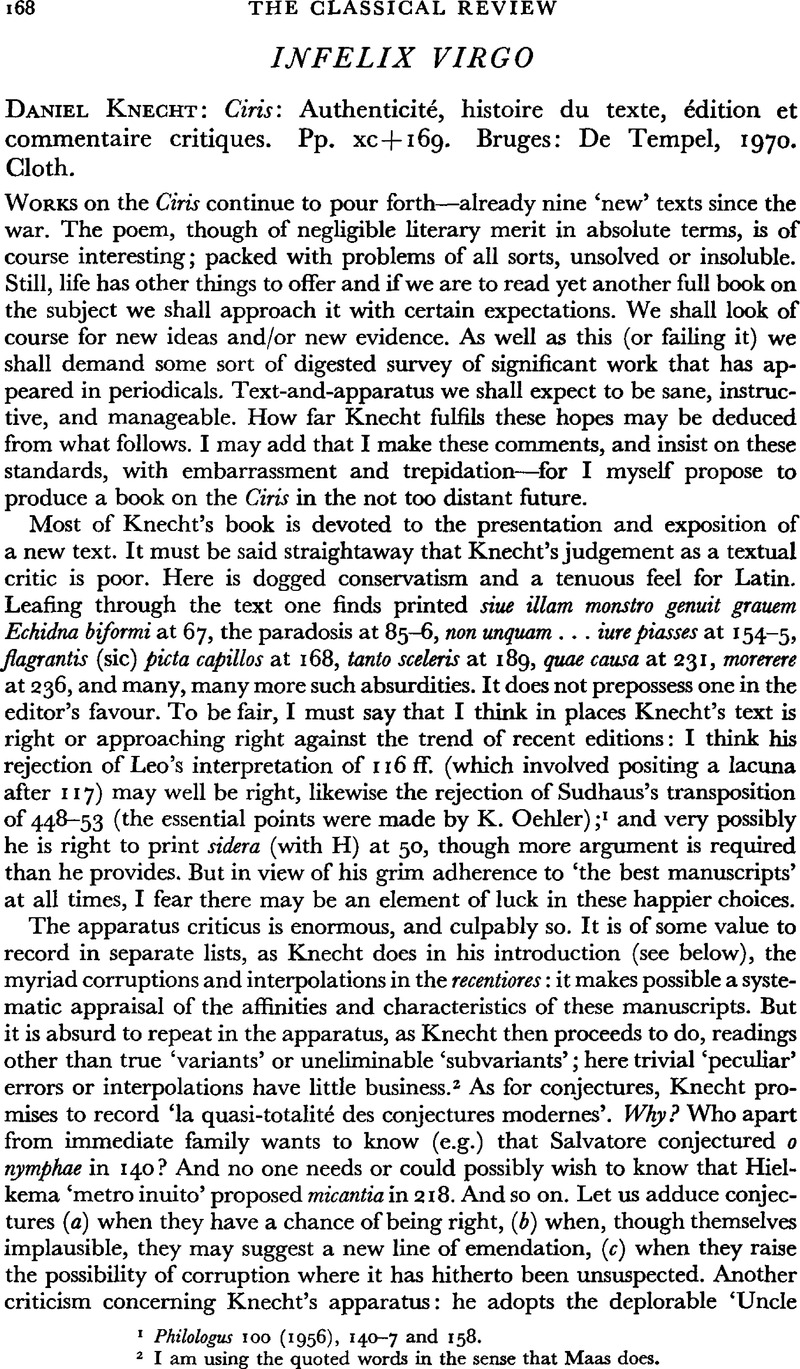No CrossRef data available.
Published online by Cambridge University Press: 27 February 2009

page 168 note 1 Philologus 100 (1956), 140–7 and 158.
page 168 note 2 I am using the quoted words in the sense that Maas does.
page 169 note 1 So confined is it (in scope that is, not extent) that it will not bother on occasions to interpret problematic lines. What is the reference of laudis amore and praemia in 1 and 2 ? What does prodigiis mean in 48 ? These and similar problems Knecht regards as no affair of his.
page 169 note 2 ‘Nous ne croyons pas que ces limitations soient arbitrages. En effet, avant le 2Oe siècle, les éditeurs, brillants latinistes, certes, mais trop peu soucieux de défendre le texte des manuscrits, modifient souvent des leçons parfaitement acceptables dans le seul but de les conformer à l'idée préconçie qu'ils se sont faite du style et de la langue du poète.
page 169 note 3 ‘Reminiscence and Imitation. Some problems in Latin Literature’, Eranos, xlvii (1949), 148–164.Google Scholar
page 169 note 4 ‘De Aetate Consolationis ad Liviam et Elegiarum in Maecenatem’, Eranos, xxviii (1930), 1–33Google Scholar; ‘Lygdamus und Ovid: zur Methodik der literarischen Prioritätsbestimmung’, Eranos, lviii (1960), 92–111Google Scholar. Axelson gives a reasonable summary of the method on p. 110 (this is quoted by E. J. Kenney in his paper ‘On the Somnium attributed to Ovid’ (ΑΓωΝ, 3 [1969], 1–14, p. 4): ‘eine vernünftige Methode operiert nicht ohne weiteres mit den Kriterien “besser” und “schlechter”, sie fragt in erster Linie, um nun die Sache so kurz—und so streng—wie möglich auszudrüucken, ob die verdächtige Fassung in ihrem organischen Zusammen-hang (wenn sie überhaupt einen hat!) ohne die parallele Fassung genetisch denkbar ist oder nicht.’ In each case of Prioritätsbestimmung we have of course to assume that there is no relevant third passage now lost. This is unprovable. But as parallels mount up between work A and work B which not only suggest a direct connection but, on the method outlined above, point to the priority of one or the other, continued harping on the possibility of a third party becomes pedantic and unreal.
page 170 note 5 e.g. A. G. Lee's article on the Lygdamus question in Proc. Camb. Phil. Soc., N.S. v (1958–9), 15–22. Mr. Lee has recently published an elegant essay entitled ‘Allusion, Parody and Imitation’ which illustrates the method largely with reference to poems in English. (The essay is published as a ‘St. John's College Cambridge Lecture’ at the University of Hull, 1971.)
page 170 note 1 On pp. xliv–xlvi Knecht seeks to resolve disagreement over readings of A and A2, even invoking the colour of the ink used by the two hands; such discrimination seems scarcely possible if a mere microfilm or photograph is being examined.
Knecht's quotations from the very imporant tant but severely obscured Graz fragment (G) are sometimes inaccurate, but as my own collations and discussion of this manuscript should shortly be published, I say no more here.
page 170 note 2 Like, for example, that of Goodyear on p. 99 of the O.C.T. Appendix Vergiliana. A more detailed stemma is attempted by Clausen, W. V. in ‘On Editing the Ciris’ (C.P. lix [1964], 90–101), 94Google Scholar. Cf. too Courtney, B.I.C.S. xv (1968), 134 ff.: there B and G are considered in the context of the transmission of the Appendix as a whole.
page 170 note 3 Corsinianus 43 F 21, Neapolitans IV E 7, Urbinas Latinus 353, Vaticanus Latinus 3255, Chigianus H V 164.
page 171 note 1 To appear in Proc. Camb. Phil. Soc. Knowing the respective speeds of publication of that journal and C.R., I should guess that the article will already be in print when this review appears.